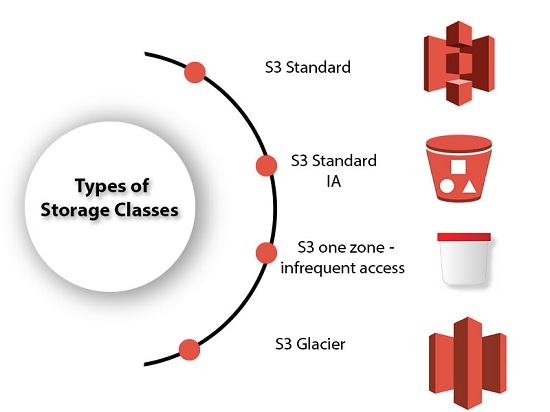Storage Services
EC2 - Backbone of AWS
AWS Route53
Database Services
Application Services
AWS VPC
- What is VPC
- Creating your own custom VPC
- Direct Connect
- NAT Gateways
- What is a Bastion Host
- VPC Endpoint
- What is a VPC FlowLog
- NACL
- What is a Security Group
- Why do we need a Data Pipeline
- AWS Lightsail
- Amazon SES
- AWS CloudFormation
- What is AWS CLI
- What is Amazon EMR
- Amazon Relational Database Service(Amazon RDS)
- AWS Athena
- What is AWS Amplify
- Amazon Cognito
- What is AWS Console
AWS Interview Questions
AWS Storage Classes
- S3 storage classes are used to assist the concurrent loss of data in one or two facilities.
- S3 storage classes maintain the integrity of the data using checksums.
- S3 provides lifecycle management for the automatic migration of objects for cost savings.

S3 contains four types of storage classes:
- S3 Standard
- S3 Standard IA
- S3 one zone-infrequent access
- S3 Glacier
- S3 storage classes are used to assist the concurrent loss of data in one or two facilities.
- S3 storage classes maintain the integrity of the data using checksums.
- S3 provides lifecycle management for the automatic migration of objects for cost savings.
-
S3 contains four types of storage classes:
- S3 Standard
- S3 Standard IA
- S3 one zone-infrequent access
- S3 Glacier
-
S3 Standard
- Standard storage class stores the data redundantly across multiple devices in multiple facilities.
- It is designed to sustain the loss of 2 facilities concurrently.
- Standard is a default storage class if none of the storage class is specified during upload.
- It provides low latency and high throughput performance.
- It designed for 99.99% availability and 99.999999999% durability
-
S3 Standard IA
- IA stands for infrequently accessed.
- Standard IA storage class is used when data is accessed less frequently but requires rapid access when needed.
- It has a lower fee than S3, but you will be charged for a retrieval fee.
- It is designed to sustain the loss of 2 facilities concurrently.
- It is mainly used for larger objects greater than 128 KB kept for atleast 30 days.
- It provides low latency and high throughput performance.
- It designed for 99.99% availability and 99.999999999% durability
-
S3 one zone-infrequent access
- S3 one zone-infrequent access storage class is used when data is accessed less frequently but requires rapid access when needed.
- It stores the data in a single availability zone while other storage classes store the data in a minimum of three availability zones. Due to this reason, its cost is 20% less than Standard IA storage class.
- It is an optimal choice for the less frequently accessed data but does not require the availability of Standard or Standard IA storage class.
- It is a good choice for storing the backup data.
- It is cost-effective storage which is replicated from other AWS region using S3 Cross Region replication.
- It has the same durability, high performance, and low latency, with a low storage price and low retrieval fee.
- It designed for 99.5% availability and 99.999999999% durability of objects in a single availability zone.
- It provides lifecycle management for the automatic migration of objects to other S3 storage classes.
- The data can be lost at the time of the destruction of an availability zone as it stores the data in a single availability zone.
-
S3 Glacier
- S3 Glacier storage class is the cheapest storage class, but it can be used for archive only.
- You can store any amount of data at a lower cost than other storage classes.
- S3 Glacier provides three types of models:
- Expedited: In this model, data is stored for a few minutes, and it has a very higher fee.
- Standard: The retrieval time of the standard model is 3 to 5 hours.
- Bulk: The retrieval time of the bulk model is 5 to 12 hours.
- You can upload the objects directly to the S3 Glacier.
- It is designed for 99.999999999% durability of objects across multiple availability zones.
-
Performance across the Storage classes
S3 Standard S3 Standard IA S3 One Zone-IA S3 Glacier Designed for durability 99.99999999% 99.99999999% 99.99999999% 99.99999999% Designed for availability 99.99% 99.9% 99.5% N/A Availability SLA 99.9% 99% 99% N/A Availability zones >=3 >=3 1 >=3 Minimum capacity charge per object N/A 128KB 128KB 40KB Minimum storage duration charge N/A 30 days 30 days 90 days Retrieval fee N/A per GB retrieved per GB retrieved per GB retrieved First byte latency milliseconds milliseconds milliseconds Select minutes or hours Storage type Object Object Object Object Lifecycle transitions Yes Yes Yes Yes


